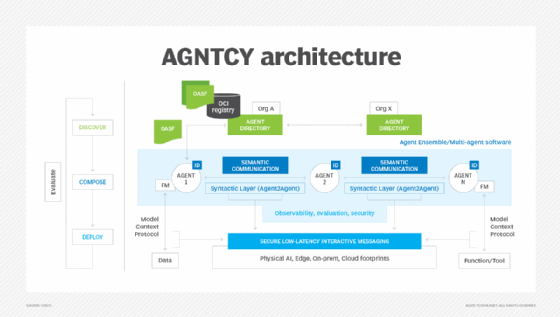Big vendors back Linux Foundation agentic workflows project
Agntcy overlaps with MCP and Agent2Agent but adds proposed standards for a broader range of network layers in the still-emerging 'internet of agents.'
Another proposed standard for agentic workflows has been accepted alongside Google's Agent2Agent by the Linux Foundation this week, with new participation from big IT vendors.
Agntcy was first released by a consortium including Cisco's Outshift incubator subsidiary, Galileo and LangChain in March. According to a Cisco press release, Google Cloud -- which donated the Agent2Agent (A2A) protocol to the Linux Foundation on June 23 -- is among new members that joined the project under the Linux Foundation. Other new members include Dell Technologies, Oracle and Red Hat.
"We want to build the entirety of the internet of agents -- how you discover, compose, deploy and evaluate multi-agent systems," said Vijoy Pandey, senior vice president and general manager of Outshift, in an April interview with Informa TechTarget. "Just like the internet allowed for composition, deployment, discovery and observability of VM and bare-metal [servers], and then the cloud did for SaaS and other services, we want to do the same thing for agentic endpoints."
Agentic AI is an emerging concept in which networks of software systems called agents, driven by large language models, autonomously collaborate to execute workflows. Although AI agents and orchestrators are offered by major cloud providers and vendors such as ServiceNow, Atlassian and IBM, large-scale agentic workflows that span frameworks and networks are still in early development. Model Context Protocol (MCP), originally created by Anthropic, has emerged as a standard for connecting AI agents with data sets and tools, while A2A is focused on how AI agents communicate with each other.
Agntcy overlaps in some ways with A2A but is also interoperable with both A2A and MCP. The major difference is that Agntcy proposes a collection of protocols that its backers claim will support more sophisticated, high-scale agentic workflows than A2A or MCP.
These include Secure Low-Latency Interactive Messaging (SLIM), which "supports various communication patterns such as request-response, publish-subscribe, fire-and-forget, and streaming," according to GitHub documentation. SLIM also builds in network security features such as authentication, authorization and end-to-end encryption.
"The Agntcy project … makes A2A agents and MCP servers discoverable through Agntcy directories, visible and transparent through Agntcy's observability SDKs, and capable of exchanging messages efficiently and securely at scale through SLIM," a Cisco spokesperson wrote in an emailed statement this week. "Cisco also has Google Cloud representation on the Agntcy technical steering committee and representation on the A2A technical steering committee to further its commitment to more deeply align the two."
As of press time, Google reps had not responded to a request for comment about how A2A and Agntcy will be more deeply integrated.
One early adopter of AI agents said Agntcy shows more promise than MCP or A2A for shoring up agentic identity and access management.
"Our use cases are very segmented into different roles and responsibilities … what one [human call center] agent should be able to see if they're interacting with an AI agent is different than what some other agent should be able to see, even if they're querying the same back-end source," said Ian Beaver, chief data scientist at Verint, a contact center-as-a-service provider in Melville, N.Y. "MCP was kind of useless to us in some ways in the beginning, because we can't just expose all our data to an agent, so we had to basically write our own interfaces, our own APIs that respected identity and permissions."
Beaver said that as Agntcy matures, he envisions using it as part of Verint's Intelligent Virtual Agent (IVA) Studio for customers.
"So somebody creates an IVA, and they can just click publish and put in their Agntcy registration server right there to be exposed to other bots and [services]," he said. "That way, they can create their own workforce of bots through our product, but we are not necessarily doing the building and deploying of those things ourselves -- we're just giving them the automated means to do that."

The 'wild west' of agentic workflows
Industry analysts said they were generally skeptical of overlapping, early-stage standards, but that support for Agntcy by well-known tech companies is a good sign for the project.
"Agntcy seems interested in creating directories and going deeper into networking [than the other protocols], so it has some potential in fostering an 'internet of agents,' if you subscribe to the belief that such a thing will happen," said Shamus McGillicuddy, an analyst at Enterprise Management Associates. "With the Linux Foundation in place and other vendors on board, it has more legitimacy and a bigger opportunity to get adopted and to have a community that drives innovation."
Still, "that whole space seems to be a wild west," McGillicuddy added. "It's hard to know what to adopt, what to commit to."
Having both projects under the Linux Foundation, with donation to an open source foundation also a stated goal for MCP, could eventually consolidate the standards, said Rob Strechay, an analyst at TheCube Research.
"I hope that the Linux Foundation, based on contributions, will pick a winner. The challenge will be the time frame in which a winner will be decided," Strechay said. "[Minimizing network] latency in these cases will be the name of the game and is in many AI deployments now."
Beth Pariseau, a senior news writer for Informa TechTarget, is an award-winning veteran of IT journalism covering DevOps. Have a tip? Email her or reach out @PariseauTT.




